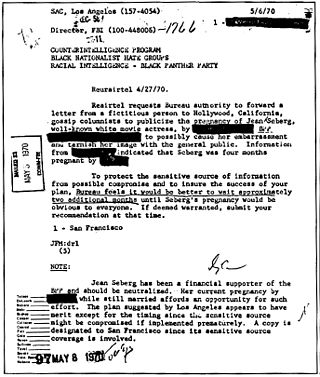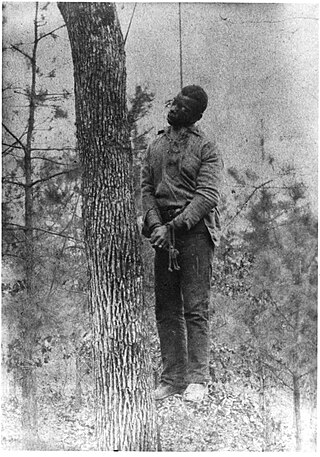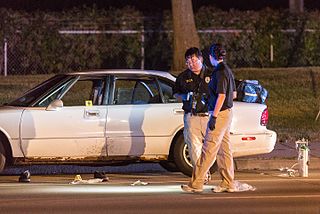
COINTELPRO was a series of covert and illegal projects conducted between 1956 and 1971 by the United States Federal Bureau of Investigation (FBI) aimed at surveilling, infiltrating, discrediting, and disrupting American political organizations that the FBI perceived as subversive. Groups and individuals targeted by the FBI included feminist organizations, the Communist Party USA, anti–Vietnam War organizers, activists in the civil rights and Black power movements, environmentalist and animal rights organizations, the American Indian Movement (AIM), Chicano and Mexican-American groups like the Brown Berets and the United Farm Workers, independence movements, a variety of organizations that were part of the broader New Left, and white supremacist groups such as the Ku Klux Klan and the National States' Rights Party.

The Ku Klux Klan, commonly shortened to the KKK or the Klan, is the name of several historical and current American white supremacist, far-right terrorist organizations and hate groups. According to historian Fergus Bordewich, the Klan was "the first organized terror movement in American history." Their primary targets, at various times and places, have been African Americans, Jews, and Catholics.

The Southern Poverty Law Center (SPLC) is an American 501(c)(3) nonprofit legal advocacy organization specializing in civil rights and public interest litigation. Based in Montgomery, Alabama, it is known for its legal cases against white supremacist groups, for its classification of hate groups and other extremist organizations, and for promoting tolerance education programs. The SPLC was founded by Morris Dees, Joseph J. Levin Jr., and Julian Bond in 1971 as a civil rights law firm in Montgomery.

Crime in Canada is generally considered low overall. Under the Canadian constitution, the power to establish criminal law and rules of investigation is vested in the federal Parliament. The provinces share responsibility for law enforcement, and while the power to prosecute criminal offences is assigned to the federal government, responsibility for prosecutions is delegated to the provinces for most types of criminal offences. Laws and sentencing guidelines are uniform throughout the country, but provinces vary in their level of enforcement.

Viola Fauver Liuzzo was an American civil rights activist in Detroit, Michigan. She was known for going to Alabama in March 1965 to support the Selma to Montgomery march for voting rights. On March 25, 1965, she was shot dead by three Ku Klux Klan members while driving activists between the cities and transportation.
Bobby Frank Cherry was an American white supremacist, terrorist, and Klansman who was convicted of murder in 2002 for his role in the 16th Street Baptist Church bombing in 1963. The bombing killed four young African-American girls and injured more than 20 other people.

Edgar Ray Killen was an American Ku Klux Klan organizer who planned and directed the murders of James Chaney, Andrew Goodman, and Michael Schwerner, three civil rights activists participating in the Freedom Summer of 1964. He was found guilty in state court of three counts of manslaughter on June 21, 2005, the forty-first anniversary of the crime, and sentenced to 60 years in prison. He appealed the verdict, but the sentence was upheld on April 12, 2007, by the Supreme Court of Mississippi. He died in prison on January 11, 2018, at age 92.
Project Exile is a federal program started in Richmond, Virginia, in 1997. Project Exile shifted the prosecution of illegal technical gun possession offenses to federal court, where they carried a mandatory minimum sentence of five years in federal prison under the federal Gun Control Act of 1968, rather than in state court. Note that federal law provides for a penalty of ten years in federal prison for being a "prohibited person", i.e., a convicted felon in possession of a firearm, as well as for falsifying information in order to obtain one, or furnishing a gun to a convicted felon.

The lynching of Michael Donald in Mobile, Alabama, on March 21, 1981, was one of the last reported lynchings in the United States. Several Ku Klux Klan (KKK) members beat and killed Michael Donald, a 19-year-old African-American, and hung his body from a tree. One perpetrator, Henry Hays, was executed by electric chair in 1997, while another, James Knowles, was sentenced to life in prison after pleading guilty and testifying against Hays. A third man was convicted as an accomplice and also sentenced to life in prison, and a fourth was indicted, but died before his trial could be completed.

Lynching was the widespread occurrence of extrajudicial killings which began in the United States' pre–Civil War South in the 1830s and ended during the civil rights movement in the 1950s and 1960s. Although the victims of lynchings were members of various ethnicities, after roughly 4 million enslaved African Americans were emancipated, they became the primary targets of white Southerners. Lynchings in the U.S. reached their height from the 1890s to the 1920s, and they primarily victimized ethnic minorities. Most of the lynchings occurred in the American South, as the majority of African Americans lived there, but racially motivated lynchings also occurred in the Midwest and border states. In 1891, the largest single mass lynching in American history was perpetrated in New Orleans against Italian immigrants.
Crime in Washington, D.C., is directly related to the city's demographics, geography, and unique criminal justice system. The District's population reached a peak of 802,178 in 1950. Shortly after that, the city began losing residents, and by 1980 Washington had lost one-quarter of its population. The population loss to the suburbs also created a new demographic pattern, which divided affluent neighborhoods west of Rock Creek Park from the less well-off neighborhoods to the east.
Crime has been recorded in the United States since its founding and has fluctuated significantly over time, with a sharp rise after 1900 and reaching a broad bulging peak between the 1970s and early 1990s. After 1992, crime rates have generally trended downwards each year, with the exceptions of a slight increase in property crimes in 2001 and increases in violent crimes in 2005-2006, 2014-2016 and 2020-2021. While official federal crime data beginning in 2021 has a wide margin of error due to the incomplete adoption of the National Incident-Based Reporting System by government agencies, federal data for 2020-2021 and limited data from select U.S. cities collected by the nonpartisan Council on Criminal Justice showed significantly elevated rates of homicide and motor vehicle theft in 2020-2022. Although overall crime rates have fallen far below the peak of crime seen in the United States during the late 1980s and early 1990s, the homicide rate in the U.S. has remained high, relative to other "high income"/developed nations, with eight major U.S. cities ranked among the 50 cities with the highest homicide rate in the world in 2022. The aggregate cost of crime in the United States is significant, with an estimated value of $4.9 trillion reported in 2021. Data from the first half of 2023, from government and private sector sources show that the murder rate has dropped, as much as 12% in as many as 90 cities across the United States. The drop in homicide rates is not uniform across the country however, with some cities such as Memphis, TN, showing an uptick in murder rates.
The United Klans of America Inc. (UKA), based in Alabama, is a Ku Klux Klan organization active in the United States. Led by Robert Shelton, the UKA peaked in membership in the late 1960s and 1970s, and it was the most violent Klan organization of its time. Its headquarters was the Anglo-Saxon Club outside Tuscaloosa, Alabama.
Whitecapping was a violent vigilante movement of farmers in the United States during the late 19th and early 20th centuries. It was originally a ritualized form of extralegal actions to enforce community standards, appropriate behavior, and traditional rights. However, as it spread throughout the poorest areas of the rural South after the Civil War, white members operated from economically driven and anti-black biases. States passed laws against it, but whitecapping continued into the early 20th century.
Bill Riccio is a leader in the white power skinhead movement in the United States who gained public notoriety for his appearance in the 1993 documentary Skinheads: Soldiers of the Race War. He has been convicted numerous times on illegal weapon possession charges, the most recent of which was in 1992.
According to the Louisiana Uniform Crime reporting program, there were 177,710 crimes reported in the U.S. state of Louisiana in 2018. 2018 had the least amount of non-violent criminal offenses since at least 2008. Violent crime decreased from 2017 to 2018, but 2012 still remains the lowest with its record of 22,868. Rape went up 12.7% from 2017 while murder/non-negligent manslaughter declined 7.8%. Additionally, robbery dropped 15% and aggravated assault dropped 1.5%. Handguns remain the leading murder weapon with a rate of 44.7% with firearm following close behind at 35.7%. Together, these two contribute for 80.4% of the murders. Similarly, robberies were committed mostly with firearms in 2018. Firearms were leading with 52% and strongarm listed with a percentage of 35%.

Crime in Minnesota encompasses a wide range of unlawful activities that occur within the state, regulated by both state and federal laws. While crime rates in Minnesota are generally below the national average, certain areas and types of crime have garnered public attention.
Prison overcrowding in the United States is a social phenomenon occurring when the demand for space in a U.S. prison exceeds the capacity for prisoners. The issues associated with prison overcrowding are not new, and have been brewing for many years. During the United States' War on Drugs, the states were left responsible for solving the prison overcrowding issue with a limited amount of money. Moreover, federal prison populations may increase if states adhere to federal policies, such as mandatory minimum sentences. On the other hand, the Justice Department provides billions of dollars a year for state and local law enforcement to ensure they follow the policies set forth by the federal government concerning U.S. prisons. Prison overcrowding has affected some states more than others, but overall, the risks of overcrowding are substantial and there are solutions to this problem.
Gary Thomas Rowe Jr., known in Witness Protection as Thomas Neil Moore, was a paid informant and agent provocateur for the FBI. As an informant, he infiltrated the Ku Klux Klan, as part of the FBI's COINTELPRO project, to monitor and disrupt the Klan's activities. Rowe participated in violent Klan activity against African Americans and civil rights groups.
The Macedonia Baptist Church is a centuries-old historically black church located in rural Clarendon County, South Carolina. It was destroyed by arsonists following direction from the local Ku Klux Klan chapter known as the Christian Knights of the Ku Klux Klan and was later rebuilt afterwards. Four Klansmen were convicted for the crime, and a subsequent civil suit effectively closed the Klan chapter's operation in the county. The successful civil suit was called a "wake-up call" indicating that racial violence would not be tolerated.








